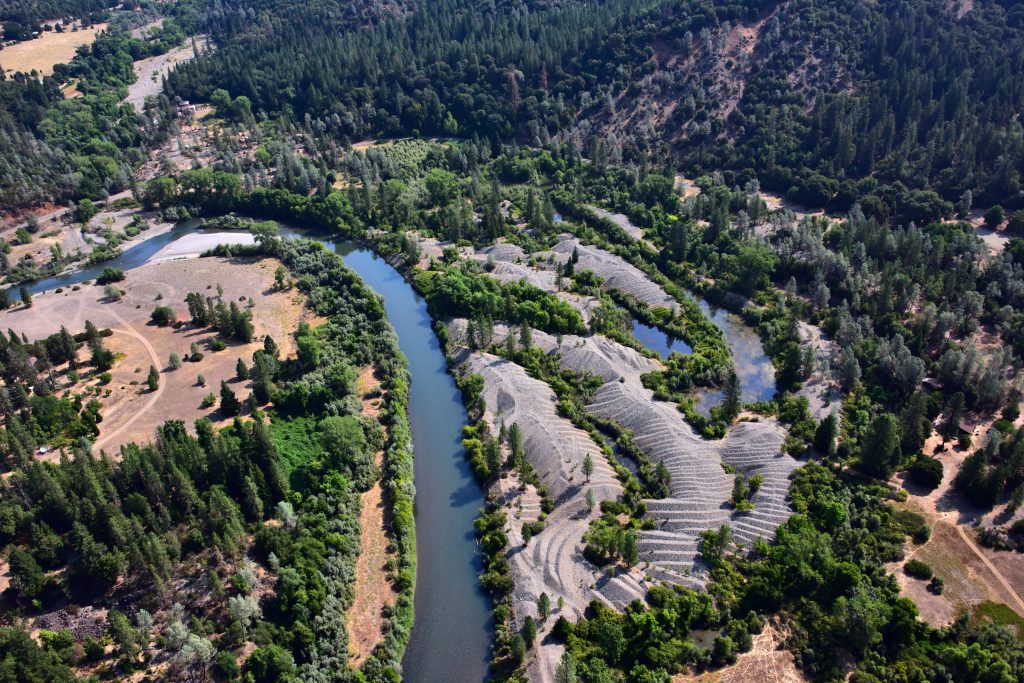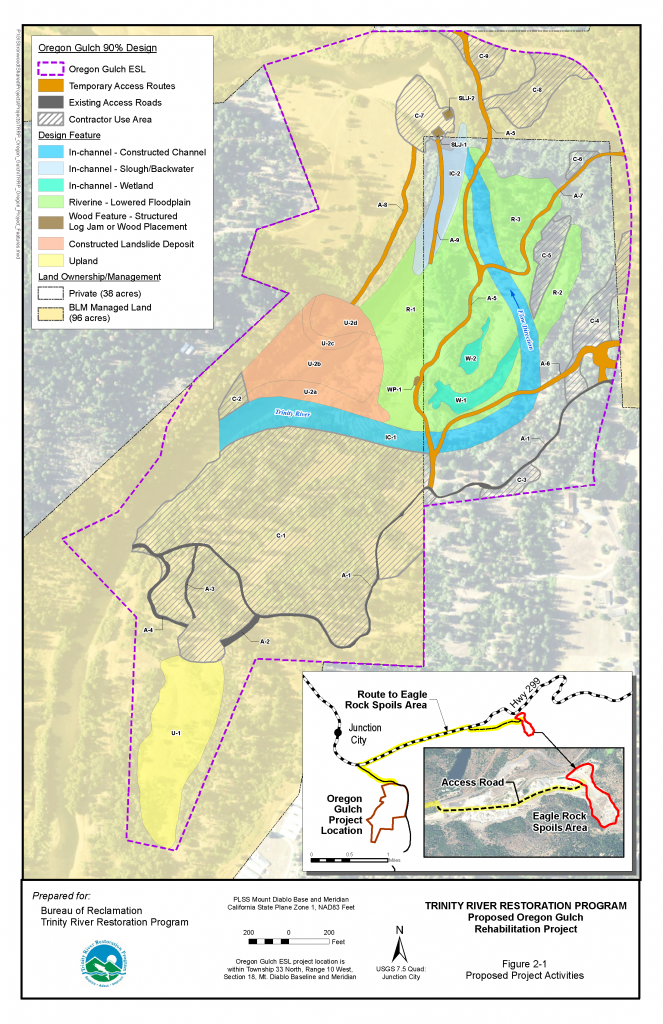The Trinity River Restoration Program (TRRP) will begin mobilization and site preparation at the Oregon Gulch Channel Rehabilitation Project site on the Trinity River in late July. The site is located on Sky Ranch Road a couple miles east of Highway 299. During phase one, the project will be hauling truckloads of old mine tailings from the site to Eagle Rock Quarry. Removal of the old mining material will permanently free up the floodplain for vegetation, fish, and wildlife. Once complete, the project will increase juvenile rearing habitat and enhance channel complexity in the Trinity River.
Equipment may be brought to the Oregon Gulch Site as early as the 21st of July and site preparation (setting up access roads, gravel processing equipment, and storage areas) will likely start the week of July 25th. By August 8th, the project should be processing and moving trucks of gravel to Eagle Rock Quarry. Our drivers will go slowly in the interest of public safety.
Oregon Gulch site gravel processing, moving of rock to Eagle Rock Quarry, and storage of materials will continue as phase one funding is available. Shutdowns will occur during inclement weather. For the remainder of 2022, all Oregon Gulch project work will take place outside of the river’s active channel and the floodway. Most of the work during phase one will be moving rocks! Please be aware of our trucks on the route between DunMovin Road (off Sky Ranch Road) and Eagle Rock Quarry on Highway 299. We will get the work done as soon as we can.
Phase two activities to restore the floodplain and perform in-river work will begin after most of the mine tailings have been removed. In-river work can only occur during the summer and will be timed accordingly. Please bear with us and our noise as we work to make lasting improvements to the river corridor.
For safety reasons, walk-in entry to active construction sites will not be allowed, but you can contact us to schedule a tour of the site. The project will be implemented by TRRP, of the Bureau of Reclamation, in collaboration with the federal co-lead agency, the Bureau of Land Management, and our California state lead agency, the North Coast Regional Water Quality Control Board.
browse the TRRP website,
or contact Oliver Rogers: 530-623-1807 / orogers@usbr.gov
Project Background
As part of Oregon Gulch Project, the TRRP completed an Environmental Assessment/Initial Study (EA/IS) to meet requirements of the National Environmental Policy Act (NEPA) and the California Environmental Quality Act (CEQA) and fully disclose our proposed plans for restoration at the site. This effort was led by Reclamation, BLM, and the California North Coast Regional Water Quality Control Board. The EA/IS evaluates and discloses potential environmental effects of implementing the Oregon Gulch Project. To encourage public (and agency) participation, this page included a general description of the project/proposed action and the purpose and need for the project.

The Oregon Gulch project site in 2016. Photo by Kenneth DeCamp, purchased by Trinity River Restoration Program, Bureau of Reclamation.
Project Goals and Objectives
The Oregon Gulch Project is designed to improve the overall function of the restoration area. The completed project would:
- Reestablish a functional, topographically–complex floodplain to promote dynamic river processes, increase river connections, and create juvenile salmon and steelhead habitat, at a greater range of flows.
- Increase in-channel habitat diversity at all flows by placing wood to interact with river flows, provide cover for fish, and increase channel complexity and groundwater retention.
- Revegetate construction–disturbed upland and riparian habitats to restore native plant diversity and fish and wildlife habitat and provide future trees for recruitment to the River.
Project Description
The Project would be only via Sky Ranch Road on river-right. Access to river-left construction areas would be made across the river. Most of the lands included in the proposed footprint are managed by the BLM-Redding Field Office (96 acres). The remainder consists of a privately owned parcel (38 acres) located in the eastern (river-right) extent of the Project area. The Oregon Gulch Proposed Project Features map (above) shows the proposed Project activity areas.
Proposed Oregon Gulch Project Schedule
- Public Scoping – October 22 – November 23, 2020
- Public Scoping Meeting – November 5, 2020
- Draft EA/IS for public comment – January 15 – February 18, 2021
- Final EA/IS and Final Decision – May 2021
- Proposed Oregon Gulch Project construction – 2021–2026
- The proposed activities would take place in two phases; excavation/removal of mine tailings to Eagle Rock (on Highway 299 ~ 3 miles from Oregon Gulch) in the first phase (2021 up to 2025) and in-river channel/floodplain rehabilitation work in the second (between 2023 to 2026).
- Initial excavation and hauling of up to 500,000 cubic yards of mine tailings could begin as early as fall 2021. Transport of this material would continue, as funding is available, for approximately 1.5 – 4 years prior to commencement of in-river restoration work planned in the second phase. The intensity of trucking materials to Eagle Rock would substantially decrease if the project duration is extended.
- When the bulk excavation and transport of mine tailing material is completed, work would shift to in-channel restoration work. In-river work would occur between July 15 and Oct. 15 and take an additional one to two seasons (summer and fall). The second phase of the project work could extend through 2026.
- Full revegetation efforts would not start until fall following in-river construction
- Post-construction revegetation and maintenance – would occur for up to 5 years post in-channel work, as needed.
Further Information:
- Oregon Gulch Channel Rehabilitation Design Report
- Environmental Assessment / Initial Study
- Signed Finding of No Significant Impact (FONSI)
Background:

